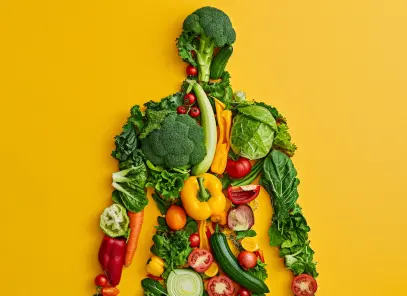
 By - nul
By - nul By - 19 Mar 2024
By - 19 Mar 2024AYURVEDA
WHAT IS AYURVEDA?
"Hitahitam Sukham Duhkham Ayustasya Hitahitam | Mananca Taccha Yatroktam Ayurvedah Sa Ucyate ||''
This verse from ancient Ayurvedic literature “Charak Samhita '' defines what is beneficial (hita) and what is detrimental (ahita) for life (ayu). Specifically, it categorizes life into four types: hitayu, ahitayu, sukhayu, and dukhayu, based on various conditions of health or illness. Ayurveda, aptly termed the "science of life," is a holistic health system with its origins in India over 5,000 years ago. The focus of Ayurveda is on maintaining balance within the body, mind, and spirit to ensure good health and prevent disease.
Key Concepts and Principles of Ayurveda
Doshas: Ayurveda posits that the universe and the human body comprise five basic elements: space (akasha), air (vayu), fire (teja), water (jala), and earth (prithvi). These elements amalgamate in specific ways to give rise to three primary bio-energetic forces or doshas: Vata, Pitta, and Kapha. Each individual possesses a unique blend of these doshas, influencing their physiological and personality traits. Nowadays,doshas are always seen in combinations.
An Ayurvedic practitioner can ascertain one’s dosha based on physical, emotional, mental, and behavioral characteristics. Here's a brief overview:
"रूक्षो लघुः शीतः खरः सूक्ष्मोचलोऽनिलः ||
" Transliteration: "Rūkṣo laghuḥ śītaḥ kharaḥ sūkṣmo chalo 'nilaḥ ||"
Translation: "Dry, light, cold, rough, subtle, mobile, and clear are the qualities of Vata." This shloka enumerates some primary attributes of Vata: Rūkṣa (Dry): Vata has a drying quality, which can be seen when there's dry skin, dry hair, etc. Laghu (Light): This signifies the light nature of Vata which contrasts the heaviness of Kapha.
Śīta (Cold): Vata is cold in nature. People with high Vata often feel cold.
Khara (Rough): A characteristic that can be associated with rough skin or irregular bowel movements.
Sūkṣma (Subtle): Vata is subtle and can quickly spread and move in the body.
Chala (Mobile): Vata is always moving and is responsible for all movements in the body, including circulation, nerve impulses, and thoughts.
Anila (Clear or Wind): Reflecting its airy nature, which is a primary component of Vata.To ensure optimal health, Vata individuals should adhere to a consistent daily routine, meditate, and consume warm foods.
Here's another shloka that describes the functions of Vata in the body:
"प्राणायामो निवेगश्च उद्वेगश्चापि सर्वदा | आक्षिप्तिः क्रिया चेष्टा च सर्वा वातस्य कर्मणाम् ||"
Transliteration: "Prāṇāyāmo nivegaśca udvegaścāpi sarvadā | Ākṣiptiḥ kriyā ceṣṭā ca sarvā vātasya karmaṇām ||"
Translation: "Respiration, initiation of action, excitement, and all bodily movements are functions of Vata."
This shloka outlines the primary roles of Vata in the body:
Prāṇāyāma (Respiration): Vata governs the process of breathing.
Nivega (Initiation of action): Vata initiates various activities in the body.
Udvega (Excitement): Emotional responses and excitement are influenced by Vata.
Ākṣiptiḥ and Kriyā Ceṣṭā (All bodily movements): Vata is responsible for all movements, from the blinking of eyes to the movement of muscles and limbs.
Pitta: Represented by fire and water, Pitta is described as hot, sharp, and oily. Summer, with its warm, sunny days, mirrors Pitta. Strengths encompass intelligence, determination, and leadership, whereas weaknesses are impatience and mood swings. Classical Ayurvedic texts that describes the qualities of Pitta:
"सस्नेहः तीक्ष्णोष्णो लघु विस्रं सरः सर | पित्तं सस्नेहतिक्ष्नोष्णं लघु विस्रं सरं द्रवम् ||"
Transliteration: "Sasnehaḥ tīkṣṇoṣṇo laghu visraṃ saraḥ sara | Pittaṃ sasnehatikṣṇoṣṇaṃ laghu visraṃ saraṃ dravam ||"
Translation: "Pitta is oily, sharp, hot, light, fleshy-smelling, spreading, and liquid."
This shloka lists the following qualities of Pitta:
Sasneha (Oily): Indicates the oily nature of Pitta.
Tīkṣṇa (Sharp): Reflects the sharp or penetrating nature of Pitta, responsible for digestion and enzymatic actions.
Uṣṇa (Hot): Represents the inherent heat in Pitta, governing digestion and metabolism.
Laghu (Light): Pitta is light in weight and can spread quickly.
Visra (Fleshy-smelling): Describes a specific type of odor associated with Pitta.
Sara (Spreading): Indicates the spreading or flowing nature of Pitta.
Drava (Liquid): Signifies the liquid consistency of Pitta.
The qualities of Pitta play a crucial role in its actions in the body, particularly concerning digestion, metabolism, body temperature, and complexion.
Individuals with dominant Pitta should strike a work-life balance and avoid excessive heat.
Here's a commonly referenced shloka from classical Ayurvedic texts that describes the qualities of Kapha:
"श्लिष्टं गुरु स्निग्धं मन्दं शीतं मृत्स्नु स्थिरं कफः |"
Transliteration: "Shliṣṭaṃ guru snigdhaṃ mandaṃ śītaṃ mṛtsnu sthiraṃ kaphaḥ |"
Translation: "Kapha is cohesive, heavy, oily, slow, cold, slimy, and stable."
This shloka lists the following qualities of Kapha:
Shliṣṭa (Cohesive): Indicates the binding or holding nature of Kapha.
Guru (Heavy): Kapha has a weighty nature which offers stability to the body.
Snigdha (Oily): Reflects the lubricating nature of Kapha.
Manda (Slow): Denotes the slow, stable nature of Kapha-related functions.
Śīta (Cold): Represents the cold quality of Kapha, which contrasts the heat of Pitta.
Mṛtsnu (Slimy or Smooth): It denotes the smooth, mucous-like quality of Kapha.
Sthira (Stable): Indicates the stabilizing quality of Kapha, offering structure and form to the body.
Understanding these qualities of Kapha can help recognize when this dosha is in balance or when it's aggravated.
Prakruti & Vikruti
Prakruti: Represents an individual's inherent constitution or doshic equilibrium at birth, remaining largely unchanged throughout their life.
Vikruti: Illustrates the present state of an individual's doshas, which can alter due to factors like diet, lifestyle, seasons, and age.
Dinacharya & Ritucharya
Ayurveda accentuates the significance of daily (Dinacharya) and seasonal (Ritucharya) regimens to sustain balance and ward off diseases.
DINCHARYA
RITUCHARYA
Rasa
"Rasa" in Ayurveda can be understood in two primary contexts:
Rasa (Taste): Ayurveda recognizes six tastes or Rasas that can be experienced by the tongue. They are:
Madhura (Sweet)
Amla (Sour)
Lavana (Salty)
Katu (Pungent)
Tikta (Bitter)
Kashaya (Astringent)
Each Rasa or taste can increase or decrease the doshas (Vata, Pitta, Kapha) and, therefore, has implications for health.
Rasa (Plasma): This refers to the first of the seven dhatus or body tissues. It is closely associated with lymph and provides nourishment to the body.
Dhatu
The term "Dhatu" refers to the seven primary tissues in the body, which are responsible for the physiological functions and structure of the body. They are:
Rasa Dhatu: As mentioned, this is associated with plasma and lymph.
Rakta Dhatu: Correlates with blood and ensures the transportation of nutrients and oxygen to cells.
Mamsa Dhatu: Represents muscle tissue, providing physical strength and support.
Meda Dhatu: Refers to adipose tissue (fat) and offers lubrication and insulation.
Asthi Dhatu: Corresponds to bone and provides structure to the body.
Majja Dhatu: Associated with bone marrow and nerve tissue.
Shukra/Artava Dhatu: Represents the reproductive tissues in both males (sperm) and females (ovum).
Panchamahabhuta
"Panchamahabhuta" means the "five great elements." According to Ayurveda, everything in the universe, including the human body, is made up of these five fundamental elements:
Akasha (Space or Ether): Represents emptiness, providing space for the other elements to exist.
Vayu (Air): Symbolizes movement and is responsible for motion and activity in the body.
Teja or Agni (Fire): Represents transformation, responsible for digestion and metabolism.
Jala (Water): Symbolizes cohesion and maintains fluid balance in the body.
Prithvi (Earth): Represents solidity and provides structure and stability.
These elements combine in the human body to form the three doshas: Vata (Air & Space), Pitta (Fire & Water), and Kapha (Water & Earth). Each individual has a unique balance of these doshas, which influences their physical, mental, and emotional characteristics.
In summary, Rasa, Dhatu, and Panchamahabhuta are fundamental concepts in Ayurveda that provide a framework for understanding health, disease, and the interplay between the individual and the universe.
OTHER CRITERIAS IN AYURVEDA ARE
MANA- SATVA, RAJA AND TAMAH
INDRIYA- 5 SENSES (TOUCH,SMELL,TASTE,VISION,SOUND)
Exercise Recommendations
Vata: Engage in less strenuous activities like mild cycling, walking, or yoga.
Pitta: Team sports are ideal, but they should avoid intense heat.
Kapha: Cardio and weight-resistance exercises are beneficial, ideally with a workout partner for motivation.


आज के इस दौर में तनाव, गतिहीन जीवन शैली और खराब पोषण काफी व्याप्त होते जा...


आयुर्वेद के अंतर्गत अगर आप अपने स्वास्थ्य को बेहतर बनाना चाहते है या फिर आप किसी...


आयुर्वेद में वजन प्रबंधन को "मेदोहर चिकित्सा" के रूप में जाना जाता है। यह आनुवांशिक कारणों...